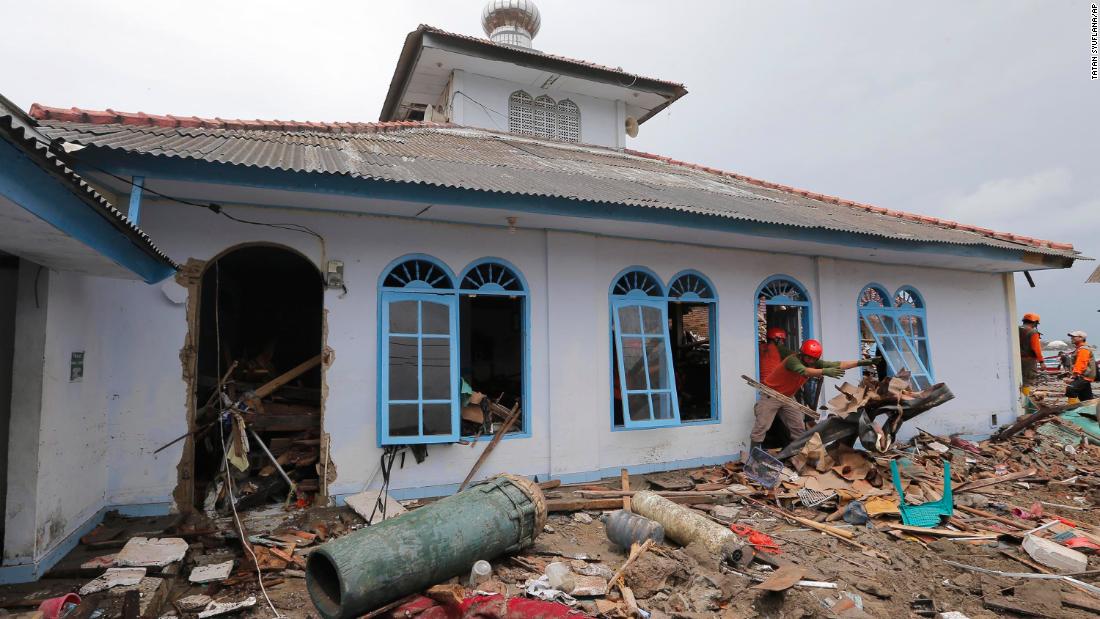
At least 429 people were killed Saturday when the tsunami -- sparked by landslides from an erupting volcano -- swept through the Sunda Strait, leaving 1,500 injured and 16,000 displaced in villages on the Javan and Sumatran coasts.
Dozens of people are still missing. The Indonesia Red Cross said Wednesday that it was sending emergency aid to the affected area, with 400 staff and volunteers supporting search and rescue efforts.
"Most survivors have been huddling in temporary shelters away from the shore, but have started to emerge to search for loved ones and assess damage to their property," said Arifin M. Hadi, Head of Disaster Management at the Indonesian Red Cross.
"Our teams are seeing many broken bones and broken homes, and people who are very shaken. Indonesians have withstood a string of disasters this year and with them, so much loss and misery."
In September, more than 2,000 people were killed after a tsunami and earthquake struck western Sulawesi, with many complaining they were caught unawares. Also, over July and August, a series of earthquakes hit the northern Lombok region, sparking landslides and collapsing buildings that left over 400 people dead.
Yet even those tolls pale in comparison to the 2004 disaster, with a 9.1-magnitude earthquake which struck near Sumatra on Boxing Day triggering a massive tsunami that hit multiple countries bordering the Indian Ocean. More than 227,000 people were killed.
No warning
In the wake of the 2004 disaster, countries including the UK, Germany and Malaysia donated detection buoys and other equipment to Indonesia to help warn of future tsunamis.
Since then, calls have been made to upgrade and replace that system. The last buoys stopped working in 2012, sparking more demands for a new system.
Multiple tsunamis have struck the country since -- including Saturday's, which came without warning, increasing the death toll and devastation.
Bapu Suwarna, a 49-year-old survivor, told CNN he first thought the sound of the tsunami was coming from a nearby music concert.
"The sound grew and I even heard crashing sounds," he said. "Seconds later I saw people running from the tsunami wave shouting 'Tsunami! Waves! Waves!'"
"It took only seconds not minutes after hearing the thunderous sounds and then the waves hit us. From the bottom of my heart, I sincerely request that the government set up an early warning system so people can anticipate an incoming tsunami. I didn't have much time, after the loud sounds were heard."
On Monday, Indonesian President Joko Widodo ordered the country's Meteorology, Climatology and Geological Agency (BMKG) to purchase tsunami detectors "that can provide early warnings to community."
Widodo claimed the tsunami which struck over the weekend was beyond Indonesia's currently ability to predict.
"Usually it was preceded by earthquake. That's why the residents and visitors in Carita and Labuan beaches and Tanjung Lesung and Sumur beaches were not prepared to escape," he said.
BMKG chief Dwikorita Karnawati said the agency would look to install tidal gates to detect waves near land, admitting the existing system was unable to warn of the tsunami ahead of time.
"This (tsunami) is caused by several factors. Our censors did not sound early warning because they are for tectonic activity not volcanic activity. That's why we are in coordination with other agencies such as the maritime and geology agencies," she said.
Volcano still erupting
The initial wave in Saturday's tsunami was triggered by a volcanic eruption that caused a 64-hectare (158-acre) chunk of Anak Krakatau to slide into the ocean.
The eruption came at high tide during a full moon, with the Sunda Strait, which runs between Java and Sumatra, also having a spell of high rainfall, government and rescue agencies said.
These factors led to a wave 3 meters (10 feet) high crashing through the Strait, sweeping beachfront homes and hotels away and killing hundreds of people.
Anak Krakatau, located about 25 to 30 miles (40 to 50 kilometers) from the Java and Sumatra coastlines, continues to erupt, leaving many residents fearing that more monster waves could hit Indonesia's shores.
Residents should be vigilant as long as the volcano remains active, said Sutopo Purwo Nugroho, a spokesman for the disaster mitigation agency.
No comments:
Post a Comment